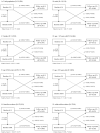The Bidirectional Relationship between Chronic Kidney Disease and Hyperuricemia: Evidence from a Population-Based Prospective Cohort Study
- PMID: 36767097
- PMCID: PMC9914133
- DOI: 10.3390/ijerph20031728
The Bidirectional Relationship between Chronic Kidney Disease and Hyperuricemia: Evidence from a Population-Based Prospective Cohort Study
Abstract
Background: Although several studies have examined the association between chronic kidney disease (CKD) and hyperuricemia (HUA), the direction of the association remains unclear. We aimed to investigate whether there was a bidirectional association between them.
Methods: The present study was conducted in three analyses. Analysis I included 25,433 participants free of HUA at baseline to evaluate the associations between CKD and estimated glomerular filtration rate (eGFR) with incident HUA. Analysis II had 28,422 participants free of CKD at baseline to analyze the relationships between HUA and serum uric acid (sUA) with new-onset CKD. Cox proportional hazards regression models were applied to evaluate the association involved in Analysis I and II. Analysis III included 31,028 participants with complete data and further dissected the bidirectional association between sUA and eGFR using cross-lag models.
Results: New-onset HUA and CKD were observed in the first round of the follow-up study among 1597 and 1212 participants, respectively. A significantly higher risk of HUA was observed in individuals with CKD compared to individuals without CKD (HR = 1.58, 95% CI: 1.28-1.95). The adjusted HRs (95% CIs) of HUA were 3.56 (2.50-5.05) for the participants in the group of eGFR less than 60 mL·min-1·1.73 m-2, 1.61 (1.42-1.83) for those in the group of eGFR between 60 and 90 mL·min-1·1.73 m-2, and 1.74 (1.42-2.14) for those in the group of eGFR more than 120 mL·min-1·1.73 m-2, compared with the group of eGFR between 90 and 120 mL·min-1·1.73 m-2. A higher risk of CKD was also observed in individuals with HUA compared to individuals without HUA (HR = 1.28, 95% CI: 1.12-1.47). Compared with the first quintile of sUA, the adjusted HR (95% CI) of CKD was 1.24 (1.01-1.51) for the participants in the fourth quantile. There was a bidirectional relationship between sUA and eGFR, with the path coefficients (ρ1 = -0.024, p < 0.001) from baseline eGFR to follow-up sUA and the path coefficients (ρ2 = -0.015, p = 0.002) from baseline sUA to follow-up eGFR.
Conclusions: The present study indicated that CKD and HUA were closely associated, and there was a bidirectional relationship between sUA and eGFR.
Keywords: chronic kidney disease; cohort study; cross lag panel model; estimated glomerular filtration rate; hyperuricemia.
Conflict of interest statement
The authors declare that the research was conducted in the absence of any commercial or financial relationships that could be construed as potential conflicts of interest.
Figures





Similar articles
-
Urate Transporter ABCG2 Function and Asymptomatic Hyperuricemia: A Retrospective Cohort Study of CKD Progression.Am J Kidney Dis. 2023 Feb;81(2):134-144.e1. doi: 10.1053/j.ajkd.2022.05.010. Epub 2022 Jul 8. Am J Kidney Dis. 2023. PMID: 35810827
-
Mortality predictive role of serum uric acid in diabetic hemodialysis patients.J Ren Nutr. 2014 Sep;24(5):336-42. doi: 10.1053/j.jrn.2014.05.005. J Ren Nutr. 2014. PMID: 25167998
-
Association between hyperuricemia and chronic kidney disease: a cross-sectional study in Bangladeshi adults.BMC Endocr Disord. 2023 Feb 21;23(1):45. doi: 10.1186/s12902-023-01304-7. BMC Endocr Disord. 2023. PMID: 36803682 Free PMC article.
-
Association of hyperuricemia with cardiovascular diseases: current evidence.Hosp Pract (1995). 2023 Apr;51(2):54-63. doi: 10.1080/21548331.2023.2173413. Epub 2023 Feb 12. Hosp Pract (1995). 2023. PMID: 36730938 Review.
-
Asymptomatic Hyperuricemia and the Kidney: Lessons from the URRAH Study.Metabolites. 2025 Jan 2;15(1):11. doi: 10.3390/metabo15010011. Metabolites. 2025. PMID: 39852354 Free PMC article. Review.
Cited by
-
Relationship between uric acid to high-density cholesterol ratio (UHR) and circulating α-klotho: evidence from NHANES 2007-2016.Lipids Health Dis. 2024 Aug 9;23(1):244. doi: 10.1186/s12944-024-02234-6. Lipids Health Dis. 2024. PMID: 39123222 Free PMC article.
-
Uric acid elevation in pediatric patients with dilated cardiomyopathy and prediction of mortality.Front Cardiovasc Med. 2024 Jul 23;11:1404755. doi: 10.3389/fcvm.2024.1404755. eCollection 2024. Front Cardiovasc Med. 2024. PMID: 39108665 Free PMC article.
References
-
- Kidney Disease: Improving Global Outcomes (KDIGO) CKD Work Group KDIGO 2012 clinical practice guideline for the evaluation and management of chronic kidney disease. Kidney Int. Suppl. 2013;3((Suppl. 1)):1–150.
-
- James S.L., Abate D., Abate K.H., Abay S.M., Abbafat C., Abbasi N., Abbastabar H., Abd-Allah F., Abdela J., Abdelalim A. Global, regional, and national incidence, prevalence, and years lived with disability for 354 diseases and injuries for 195 countries and territories, 1990–2017: A systematic analysis for the Global Burden of Disease Study 2017. Lancet. 2018;392:1789–1858. doi: 10.1016/S0140-6736(18)32279-7. - DOI - PMC - PubMed
-
- Bikbov B., Purcell C., Levey A.S., Smith M., Abdoli A., Abebe M., Adebayo O.M., Afarideh M., Agarwal S.K., Agudelo-Botero M. Global, regional, and national burden of chronic kidney disease, 1990–2017: A systematic analysis for the Global Burden of Disease Study 2017. Lancet. 2020;395:709–733. doi: 10.1016/S0140-6736(20)30045-3. - DOI - PMC - PubMed
Publication types
MeSH terms
Substances
LinkOut - more resources
Full Text Sources
Medical
Research Materials
Miscellaneous

